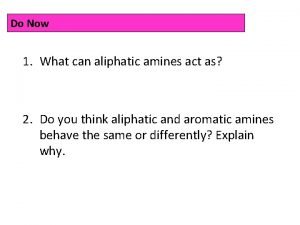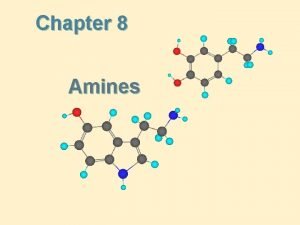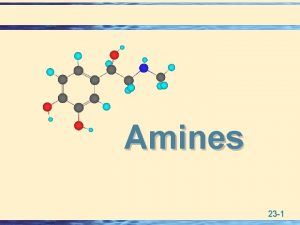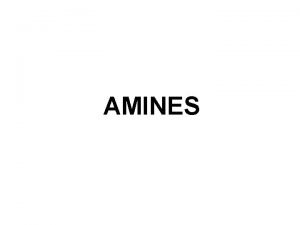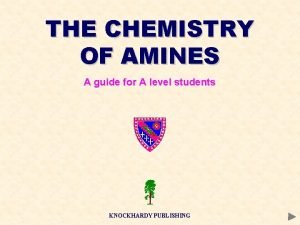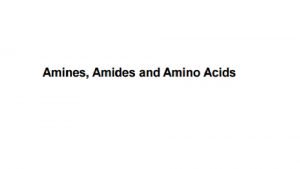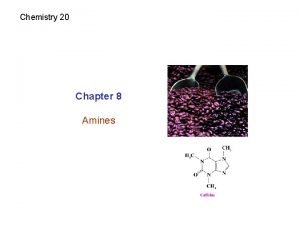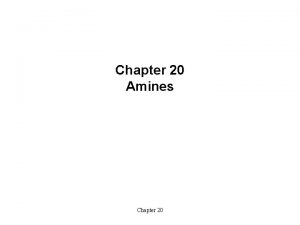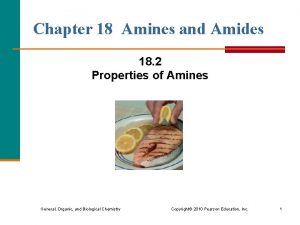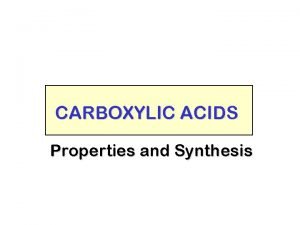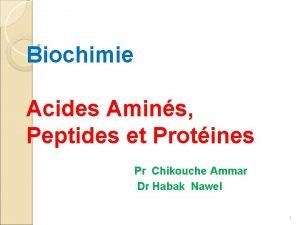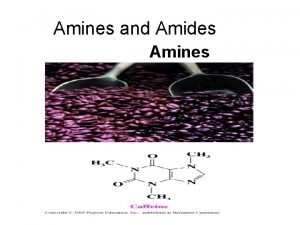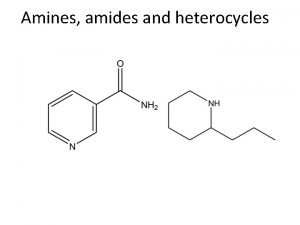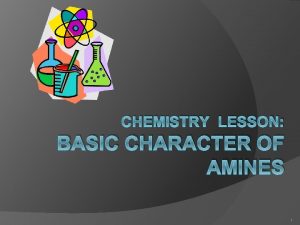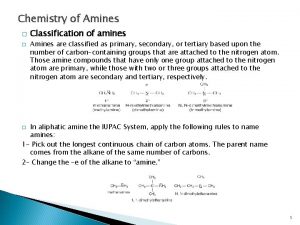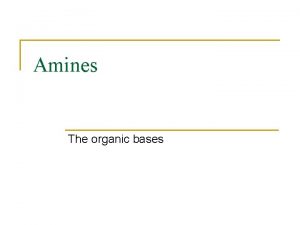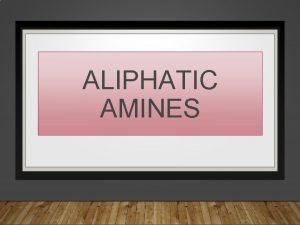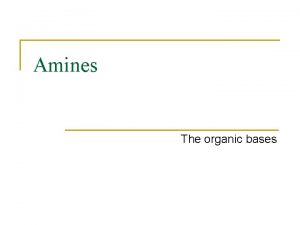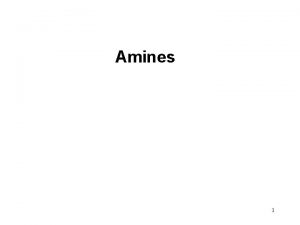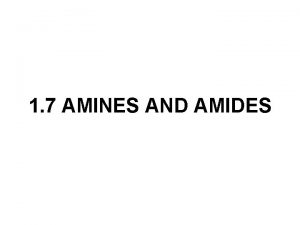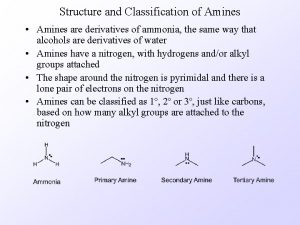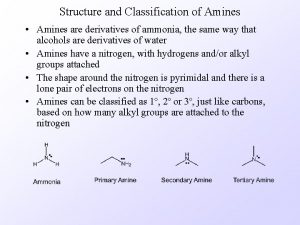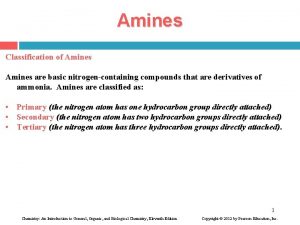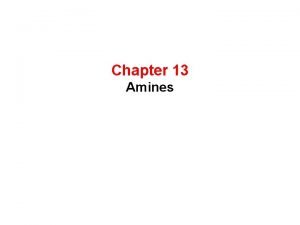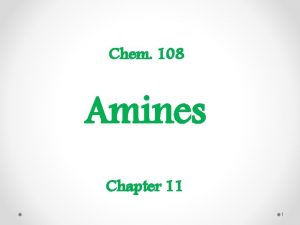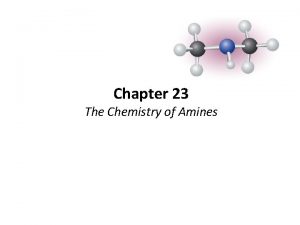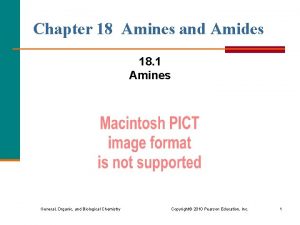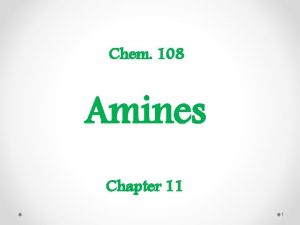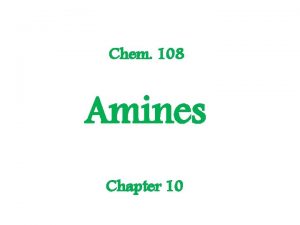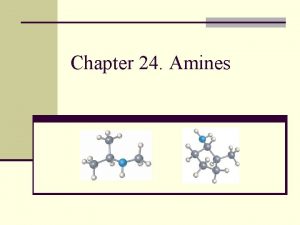Chapter 15 Amines Structure Classification l Amines are






















- Slides: 22

Chapter 15 Amines

Structure & Classification l Amines are classified as 1°, 2°, or 3° depending on the number of carbon groups bonded to nitrogen

Structure & Classification l heterocyclic amine: an amine in which the nitrogen atom is part of a ring

Nomenclature l IUPAC names Similar to alcohols l drop the final -e of the parent alkane and replace it by -amine l use a number to locate the amino group on the parent chain l

Nomenclature l IUPAC names (cont’d) l l l IUPAC nomenclature retains the common name aniline for C 6 H 5 NH 2, the simplest aromatic amine use numbers to locate substituents or, alternatively, use the prefixes ortho (o), meta (m), and para (p) common names are still widely used

Nomenclature l IUPAC names (cont’d) l l l name unsymmetrical secondary and tertiary amines as N-substituted primary amines take the largest group bonded to nitrogen as the parent amine smaller group(s) are substituents indicated by using the prefix N

Nomenclature l Common l names for most aliphatic amines, list the groups bonded to nitrogen in alphabetical order in one word ending in the suffix -amine

Nomenclature l Amine salts when four things are bonded to a nitrogen atom, the nitrogen bears a positive charge l name the compound as a salt l replace the ending -amine (or aniline or pyridine or the like) by -ammonium (or anilinium or pyridinium or the like) and add the name of the anion l

Physical Properties l Like ammonia, low-molecular-weight amines have very sharp, penetrating odors trimethylamine, for example, is the pungent principle in the smell of rotting fish l two other particularly pungent amines are 1, 4 -butanediamine (putrescine) and 1, 5 pentanediamine (cadaverine) l

Physical Properties l Amines l are polar compounds both 1° and 2° amines have N-H bonds, and can form hydrogen bonds with one another

Physical Properties an N-H---N hydrogen bond is weaker than an O-H---O hydrogen bond l compare the boiling points of ethane, methanamine, and methanol l

Physical Properties all classes of amines form hydrogen bonds with water and are more soluble in water than are hydrocarbons of comparable molecular weight l most low-molecular-weight amines are completely soluble in water l higher-molecular-weight amines are only moderately soluble in water or are insoluble l

Basicity of Amines l Like ammonia, amines are weak bases, and aqueous solutions of amines are basic l the acid-base reaction between an amine and water involves transfer of a proton from water to the amine

Basicity of Amines l The base dissociation constant, Kb, for the reaction of an amine with water has the following form, illustrated for the reaction of methylamine with water to give methylammonium hydroxide l p. Kb is defined as the negative logarithm of Kb

Basicity of Amines aliphatic amines SS bases than NH 3 l aromatic amines are weaker bases l

Basicity of Amines l We can determine which form of an amine exists in body fluids, p. H 7. 40 l if an aliphatic amine is dissolved in blood, it is present predominantly as its protonated (conjugated acid) form

Reactions of Amines l The most important chemical property of amines is their basicity l amines, whether soluble or insoluble in water, react quantitatively with strong acids to form water-soluble salts

Reactions of Amines l example: complete each acid-base reaction and name the salt formed

Reactions of Amines example: complete each acid-base reaction and name the salt formed l solution: l

Synthesis of Amines l 1) Alkyl halides react with ammonia to make primary amines l l l This can lead to multiple amination products Example on board 2) Alkyl halides may be reacted with cyanide and then hydrogenated to for the primary amine exclusively. l Example on board

Reactions of Amines l 3) Aldehydes and ketones can condense with primary amines and then be hydrogenated to for secondary amines l Example on the board

Amines End Chapter 16
 Insidan region jh
Insidan region jh Aliphatic amines
Aliphatic amines Aliphatic amines and aromatic amines
Aliphatic amines and aromatic amines Classification of amines
Classification of amines Primary aliphatic amines
Primary aliphatic amines Vital amines meaning
Vital amines meaning Amino acid optical isomers
Amino acid optical isomers Amine functional group
Amine functional group Dissociation des acides aminés
Dissociation des acides aminés Amine vasoactive
Amine vasoactive Physical properties of amines
Physical properties of amines Amines geometry
Amines geometry Amines hydrogen bonding
Amines hydrogen bonding Reaction between carboxylic acid and amine
Reaction between carboxylic acid and amine Dissociation des acides aminés
Dissociation des acides aminés Cyclic amine
Cyclic amine Amines hydrogen bonding
Amines hydrogen bonding Solubility of amines
Solubility of amines Basicity amines
Basicity amines Do aromatic amines give hinsberg test
Do aromatic amines give hinsberg test Benzoylation reaction of amines
Benzoylation reaction of amines Basic character of amines
Basic character of amines Chronotropic effect
Chronotropic effect

